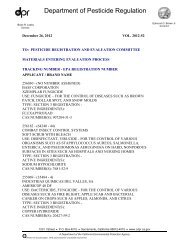Dichlorvos (DDVP) Risk Characterization Document - California ...
Dichlorvos (DDVP) Risk Characterization Document - California ...
Dichlorvos (DDVP) Risk Characterization Document - California ...
Create successful ePaper yourself
Turn your PDF publications into a flip-book with our unique Google optimized e-Paper software.
food service facilities); hand-held application to farm livestock (except poultry); use on turf, ornamental<br />
lawns and plants; use in airplanes; pet flea collars; and use in trucks, shipholds, and railcars.<br />
Restrictions were placed on the use of <strong>DDVP</strong> in greenhouses and mushroom houses, passenger<br />
buses, kennels, feedlots, animal premises, livestock, manure, and garbage dumps.<br />
The oral reference dose (RfD) of 0.0005 mg/kg-day previously set for <strong>DDVP</strong> has been withdrawn by<br />
the USEPA pending further review of the data (USEPA, 1993a). The World Health Organization<br />
(WHO) acceptable daily intake (ADI) is 0.004 mg/kg-day (WHO, 1993) based on the absence of<br />
erythrocyte ChE inhibition in human volunteers given <strong>DDVP</strong> 0.9 mg three times a day for 21 days<br />
(Boyer et al., 1977). The Permissable Exposure Level (PEL) in the air for occupational exposure is<br />
0.1 ppm (0.9 mg/m 3 ) set by the American Conference of Governmental Industrial Hygienists and<br />
required by the <strong>California</strong> Department of Occupational Health Administration (Barclays <strong>California</strong><br />
Code of Regulations, 1991).<br />
C. TECHNICAL AND PRODUCT FORMULATIONS<br />
Amvac Chemical Corp. is the primary registrant for technical <strong>DDVP</strong> in the US (Farm Chemicals<br />
Handbook, 1991). In addition to technical <strong>DDVP</strong>, <strong>DDVP</strong> is found in liquid formulations, resin strips,<br />
flea collars, foggers, and pressurized sprays.<br />
D. USAGE<br />
In <strong>California</strong>, the reported use was 5900, 5700, and 3600 pounds for 1991, 1992, and 1993,<br />
respectively (DPR, 1993). The major uses are for pest control in structures and on livestock (cattle<br />
and poultry), each use accounting for 30-40% of total pounds. The only direct food uses were on<br />
cucumbers, nut crops, and processed commodities and were 10% or less of the total. Lesser<br />
amounts are used in landscape maintenance, in nursery (non-food), and other pest control sites.<br />
The use of <strong>DDVP</strong> on mushrooms and figs is no longer on the <strong>California</strong> registered labels. The only<br />
greenhouse use formulations were Flora-Fog for cucumbers, tomatoes, lettuce, and radishes and<br />
GH-19 for tomatoes. The application rate was 1 ounce/3000 ft 3 (or 1 gm/1000 ft 3 ) and the preharvest<br />
interval for both products was 24 hours after application. There is no pre-slaughter interval for the use<br />
of <strong>DDVP</strong> directly on the skin of livestock. Label instructions include directions to use an approved<br />
cleaning solution to clean teats prior to milking.<br />
E. ILLNESS REPORTS<br />
From 1982 to 1990, 78 cases of human illness and/or injury were reported to the <strong>California</strong> Pesticide<br />
Illness Surveillance Program that were associated with exposure to <strong>DDVP</strong> (Mehler, 1993; Appendix<br />
B). The cases included 60 systemic illnesses, 12 eye injuries, and 6 skin injuries. No hospitalizations<br />
were reported and only 1-2 work day losses for 5 cases. A survey of poison control centers showed<br />
several reports of children who chewed on <strong>DDVP</strong>-containing resin strips, but without clinical<br />
symptoms (Gillette, 1972). Ingestion of 400 mg/kg <strong>DDVP</strong> was lethal to a man in a suicide, while 100<br />
mg/kg was sublethal to a woman who survived after intensive treatment (Hayes, 1982).<br />
6
















